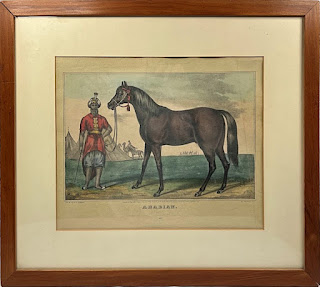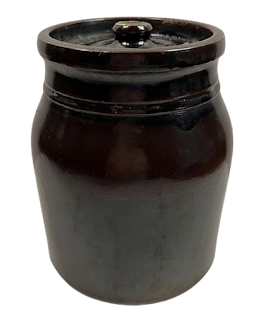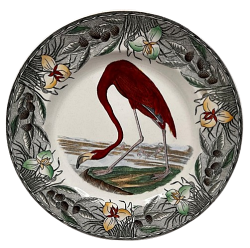A fine example of an antique redware piece, this storage jar dates from the mid-1800's. It was turned on a wheel and the potter's finger marks can be felt on the inside. The jar was coated with a transparent glaze to seal the surfaces inside and out, except for the rolled rim surrounding the mouth, which was left dry.
Folk Art Two-Sided Chicken Doorstop
A great piece of country folk art, this double-sided pecking chicken doorstop has so much personality! It was hand cut out of sheet iron and hand painted, one side in yellow, orange, green and red; the other side is a completely different bird in tones of brown, green, red and beige, speckled with spots.Mounted on a heavy, curved piece of iron, it's sturdy and not easily tipped over. The iron rod that attaches the figure to the stand is cleverly painted to blend in and is clenched underneath the stand. The figure swivels on the stand to face in different directions--as shown in our photos.
Currier Original Hand Colored Framed ARABIAN Lithograph
Nathaniel Currier (1838-1888) first published this difficult to find print in 1846, at his workrooms located at 33 Spruce Street, New York, New York. This was 11 years before he made James Ives his partner, when the business was renamed Currier & Ives. The inscription below the image reads from left to right: " LITH. & PUB. BY N. CURRIER, Entered according to Act of Congress in the year 1846 by N. Currier, in the Clerk's office of the District Court of the Southern District of N.Y. 33 Spruce St. N.Y."
Martine Azema famed French Ceramicist Wall Plate
The famed French ceramicist Martine Azema (1945-2011) created this beautiful plate in the 1970's in Vallauris, France. Hand enameled on terracotta clay, the piece was given a creamy pearlescent glaze and then decorated with a wonderfully imaginative, incised scene. The maiden has red lips and long cascading golden hair decorated with a garden of red flowers. Overhead is a bright orange sun, shining on the small black sailboat floating on the azure sea. Its tricolored sail is attached to the central mast, dividing the scene---and the sun--into halves. The enameling is brilliant and high gloss.
Framed 1931 Watercolor of Fishing Boats
Listed California artist Marie Vaughan Smith (1892-1977) painted this impressionist watercolor in 1931. The title is "Fishing Boats," done when the artist lived in South Pasadena. After studying art at various universities in California, Chicago and Oregon, she attended Chouinard Art Institute in L.A., where she studied under Millard Sheets, one of the earliest artists of the California Regionalist movement, with which Smith became associated.
Antique Stoneware Jar with Original Lid
This great stoneware jar is in wonderful condition! Hand made by an unknown potter whose finger marks are visible inside the jar, it is covered inside and out with dark brown Albany slip.
The finish is glossy and there are drips of the dark brown glaze, with the lower half of the jar darker than the upper half (some of this is a bit difficult to photograph).
There is a groove encircling the jar, just below the neck, that is decorative but also served a purpose to preserve the contents. One method was to use a heavy thread or twine to hang the jar in a warm room or by the fireplace, which would dry the fruits and vegetables to prevent them from molding, a primitive form of modern dehydration. Another method used "egg paper": layers of parchment paper dipped in egg whites and then tied over the mouth of the jar. This apparently dried into a very tight seal.
















